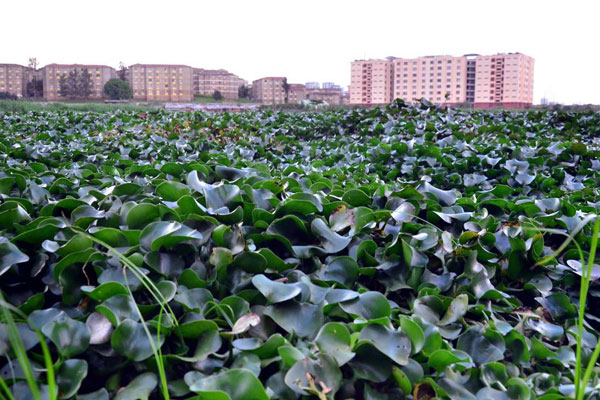 Flourishing water hyacinth in Nairobi Dam. The sea weed is now used by Kenyan farmers as the best substrate to grow oyster mushroom. Photo courtesy.
Flourishing water hyacinth in Nairobi Dam. The sea weed is now used by Kenyan farmers as the best substrate to grow oyster mushroom. Photo courtesy.
Some Kenyan farmers are using water hyacinth from Lake Victoria and Nairobi Dam to grow oyster mushroom. The floating plant has been branded ‘stubborn weed’ and perceived as a weed to be exterminated by many but the farmers say it provides a good substrate for the mushrooms.
Naftali Oseka, a farmer who lives and operate near Lake Victoria, the largest fresh water lake in Africa and which has been invaded by the sea weed has learned that dry hyacinth can be used as the best substitute of farm waste such as sugarcane thrash, sawdust and banana leaves to grow oyster mushrooms.
“This weed which is ever growing on the lake discouraged me from fishing two years ago but I have since realized that it can be a good medium in producing mushrooms and still earn a living,” said Oseka.
“I do not grow crops such as wheat where I can harvest straw to us as substrate and buying them would mean scaling up my production costs.”
RELATED ARTICLE: University launches machine that produces biogas from water hyacinth
According to John Muchura, a mushroom farmer from Juja, Kiambu County which neighbours Nairobi, there are more than adequate supplies of the aquatic weed from Nairobi Dam which farmers can access freely.
“There are many mushroom farmers around the city and instead of travelling all along to Mwea to buy rice straws, they can cheaply collect the flourished water hyacinth in the dam to grow mushrooms,” said Muchura.
He says the weed is best for producing oyster mushrooms because unlike other varieties of mushroom such as button, oyster mushrooms are primary decomposers and they can thrive well on dry fibres of water hyacinth.
RELATED ARTICLE: Water hyacinth turned to animal feed
The farmers harvest water hyacinth which they then dry on sunlight before transporting it to the farm as the dry matter is lighter and easy to transport.
The dry matter is then soaked for three days and heaped for fermentation for four to six days in a closed container.
After the fermentation process, it is sterilized through boiling in closed pots for 12 hours in order to eliminate unwanted organisms and bacteria. After cooling, it is filled in small polyethylene plastic bags using common bowls, to serve as a substrate.
“A good substrate should be composed by 65 to 75 per cent of moisture, and for the remaining part by agricultural waste,” said Muchura.
A 5x20 metres grass-thatched mud house can produce 20 punnets which is equivalent to five kilos of oyster mushrooms per day. A punnet currently goes at Sh100 translating to about Sh2000 a day.
RELATED ARTICLE: The growing medium that offers 100 per cent seed germination than soil
The possibility of growing mushrooms on a water hyacinth substrate was first demonstrated by Professor S.T. Chang of the Chinese University of Hong Kong, and was put into practice by Margaret Tagwira, a laboratory technician at the African University of Mutare in Zimbabwe.
In Africa production of oyster mushroom using water hyacinth as a substrate has been supported by Zero Emissions Research Initiative (ZERI) foundation and the United Nations Development Programme.
According to the National Farmers Information Service (NAFIS), Kenya produces an estimated 500 tonnes of mushrooms annually valued at Sh340m against a demand of 1200 tonnes therefore leaving a deficit of 700 tonnes.
















Comments powered by CComment